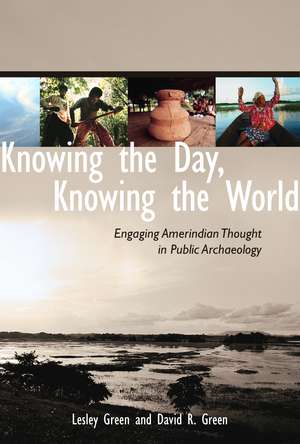Knowing the Day, Knowing the World: Engaging Amerindian Thought in Public Archaeology
Autor Lesley Green, David R. Greenen Limba Engleză Hardback – 4 dec 2013
Based on more than a decade of research in Palikur lands known as Arukwa in the state of Amapá, Brazil, Knowing the Day, Knowing the World reconsiders the dialogue between formal scholarship and Amerindian ways of knowing. Beginning and ending with a public archaeology project in the region, the book engages head-on with Amerindian ways of thinking about space, time, and personhood. Demonstrating that Palikur knowledges are based on movement and a careful theorization of what it means to be present in a place, the book makes a sustained case for engaging with different ways of knowing. It shows how this kind of research can generate rich dialogues about nature, reality, and the ethical production of knowledge.
The structure of the book reflects a gradual comprehension of Palikur ways of knowing during the course of field research. The text enters into the ethnographic material from the perspective of familiar disciplines—history, geography, astronomy, geometry, and philosophy—and explores the junctures in which conventional disciplinary frameworks cannot adequately convey Palikur understandings. Beginning with reflections on questions of personhood, ethics, and ethnicity, the authors rethink assumptions about history and geography. They learn and recount an alternative way of thinking about astronomy from the Palikur astronomical narratives, and they show how topological concepts embedded in everyday Palikur speech extend to different ways of conceptualizing landscape. In conclusion, they reflect on the challenges of comprehending alternative cosmologies and consider the insights that come from allowing ethnographic material to pose questions of modernist frameworks.
The structure of the book reflects a gradual comprehension of Palikur ways of knowing during the course of field research. The text enters into the ethnographic material from the perspective of familiar disciplines—history, geography, astronomy, geometry, and philosophy—and explores the junctures in which conventional disciplinary frameworks cannot adequately convey Palikur understandings. Beginning with reflections on questions of personhood, ethics, and ethnicity, the authors rethink assumptions about history and geography. They learn and recount an alternative way of thinking about astronomy from the Palikur astronomical narratives, and they show how topological concepts embedded in everyday Palikur speech extend to different ways of conceptualizing landscape. In conclusion, they reflect on the challenges of comprehending alternative cosmologies and consider the insights that come from allowing ethnographic material to pose questions of modernist frameworks.
Preț: 378.08 lei
Preț vechi: 511.43 lei
-26% Nou
Puncte Express: 567
Preț estimativ în valută:
72.36€ • 75.42$ • 60.24£
72.36€ • 75.42$ • 60.24£
Carte indisponibilă temporar
Doresc să fiu notificat când acest titlu va fi disponibil:
Se trimite...
Preluare comenzi: 021 569.72.76
Specificații
ISBN-13: 9780816530373
ISBN-10: 0816530378
Pagini: 256
Ilustrații: 21 photos
Dimensiuni: 152 x 229 x 28 mm
Greutate: 0.57 kg
Ediția:First Edition
Editura: University of Arizona Press
Colecția University of Arizona Press
ISBN-10: 0816530378
Pagini: 256
Ilustrații: 21 photos
Dimensiuni: 152 x 229 x 28 mm
Greutate: 0.57 kg
Ediția:First Edition
Editura: University of Arizona Press
Colecția University of Arizona Press
Notă biografică
Lesley Green is an associate professor of anthropology in the School of African and Gender Studies, Anthropology and Linguistics at the University of Cape Town, South Africa, where she leads the contested Ecologies Research cluster. David R. Green has worked as a translator and videographer on this project since 1997.
Cuprins
List of Illustrations
Preface
Acknowledgments and a Note on Authorship
Introduction. “The Things Left in the Ground”: Introducing Archaeology to Arukwa
1. “Are You Here?”: Personhood, Presence, Knowledges, and Knowing
2. “So Many Stories on This Day-World”: History as the Retracing of Tracks
3. Journeys with the Rain Stars: Making Sense of the Moving Cosmos
4. The Curvature of Surfaces: Cartesian Space, the Topology of Palikur Grammar, and Consubjective Space
5. “Reading the Tracks of the Ancestors”: Resources for Assembling Times Past
6. The Story Trails of Kwap: Archaeology, Provenance, and an Ecology of Predation
Epilogue. Beyond Matter Set in Space and Time: Engaging A merindian Thought in Public Archaeology
Notes
Bibliography
Index
Preface
Acknowledgments and a Note on Authorship
Introduction. “The Things Left in the Ground”: Introducing Archaeology to Arukwa
1. “Are You Here?”: Personhood, Presence, Knowledges, and Knowing
2. “So Many Stories on This Day-World”: History as the Retracing of Tracks
3. Journeys with the Rain Stars: Making Sense of the Moving Cosmos
4. The Curvature of Surfaces: Cartesian Space, the Topology of Palikur Grammar, and Consubjective Space
5. “Reading the Tracks of the Ancestors”: Resources for Assembling Times Past
6. The Story Trails of Kwap: Archaeology, Provenance, and an Ecology of Predation
Epilogue. Beyond Matter Set in Space and Time: Engaging A merindian Thought in Public Archaeology
Notes
Bibliography
Index
Descriere
Based on more than a decade of research in Palikur lands known as Arukwa in the state of Amapá, Brazil, Knowing the Day, Knowing the World demonstrates both the challenges of comprehending alternative cosmologies and the rich rewards of grappling with Amerindian ways of thinking and knowing.
